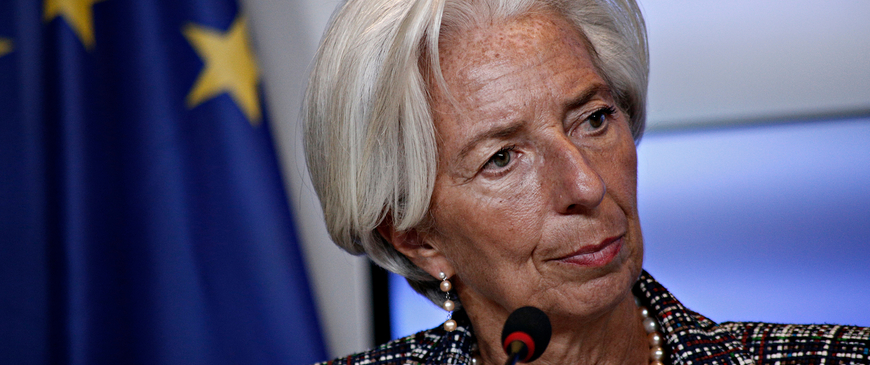
A new EU fiscal regime could make the ECB truly independent
The ECB must be free to target inflation and prevent spreads rising without encouraging fiscal irresponsibility. A new, credible fiscal regime is needed, with a permanent EU green investment fund at its centre.
In an emergency meeting on June 15th, the European Central Bank (ECB) announced that it would introduce an ‘anti-fragmentation’ tool (although it said it needed more time to work out the details). The tool would involve the central bank buying sovereign bonds of southern European countries – especially Italy – to persuade financial markets that the ECB would act to prevent borrowing costs from spiralling out of control. Due to the size of its debts, Italy is the most serious problem, and its borrowing costs rose rapidly in June, causing a headache for central bankers. But the ECB also needs to avoid encouraging fiscal irresponsibility. If the ECB buys up Italian debt to keep yields down, a new Italian government might be encouraged to borrow more.
The EU’s fiscal rules are intended to constrain government borrowing, but they are widely disparaged as ineffective at best, and counterproductive at worst. The EU first suspended the rules after the pandemic spread to Europe, and continued to suspend them after Russia’s invasion of Ukraine. And massive public investments are needed in energy infrastructure, insulation of buildings, transport and defence to meet climate targets and counter the Russian threat. A new fiscal regime could allow the ECB to ensure monetary policy is effective, without weakening the resolve of governments to keep debts sustainable. A permanent investment fund modelled on the current recovery fund (Next Generation EU, NGEU) could help to address both issues. First, it would enable some burden-sharing with fiscally constrained countries on European public goods like climate and defence, relieving some spending pressures; and second, it would give the Commission more powers to enforce compliance with fiscal targets agreed with member-states.
The EU’s fiscal rules are intended to constrain government borrowing, but they are widely disparaged as ineffective at best, and counterproductive at worst.
Southern European borrowing costs rose swiftly after the ECB signalled that it would end asset purchases and start tightening monetary policy on June 9th. Member-states have refused to use the EU’s emergency lending programmes set up during the eurozone’s sovereign debt crisis. The ECB’s Outright Monetary Transactions programme (OMT) and the EU’s European Stability Mechanism (ESM) were designed to provide emergency lending for governments that lost access to debt markets, in exchange for reform programmes. But when the pandemic struck, no one seriously thought any government would apply for an ESM programme – a precondition for the ECB to stop yields from spiralling in the short term, by buying its bonds under OMT. Instead, the EU created new tools that could be used more quickly, or with less intrusive conditions, such as SURE (which provided emergency loans to support short-term work schemes early in the pandemic, funded by EU borrowing), the ECB’s Pandemic Emergency Purchase Programme (a quantitative easing programme, which also began early in the pandemic), and NGEU (€750 billion of grants and loans for member-states, also funded by EU borrowing).
So what is the ECB to do? If it buys Italian debt while selling bonds of other member-states, it could open itself up to a legal challenge: the bank is prohibited from monetary financing – creating money and passing it directly to governments – by the treaties. In 2020, the ECB said that it would be willing to buy any member-state’s debt without limit to prevent financial stress during the pandemic. Back then, the bank could make two arguments to deny it was financing governments with ECB-created money. First, the pandemic was a liquidity crunch, as markets fled to safety during a period of extreme uncertainty, so temporary lending to stressed sovereigns was not primarily intended to finance government spending. Second, doing nothing would mean that the ECB had no hope of hitting its inflation target, because a flight from Italy would lead to a financial crisis that might spread to other countries.
But during a tightening cycle, these arguments might be less convincing, if a court case were brought against the central bank. By buying Italian bonds, the bank would be exposing its balance sheet to Italy’s solvency risks, and if Italy’s debt became unsustainable in the future, that might cause the bank to hesitate to tighten monetary policy to keep inflation under control. Higher interest rates now might affect Italy’s long-term debt sustainability, but the solution to that – in the medium term – is for Italy to raise taxes or cut spending. And, there is now a conflict between Italy’s financial stresses and the ECB meeting its inflation target by raising rates: the latter worsens the former.
The answer to this conundrum: the ECB needs to be able to independently meet its inflation target, and, in extremis, prevent a liquidity crunch from creating a financial crisis in Italy or other member-states. It also needs to ensure that interest rates are reasonably even across the monetary union, especially in the absence of an agreement between the member-states on completing the banking union. Italian and German companies should not be subject to widely different interest rates because of their sovereign’s debts. And the ECB should not have to wait for an ESM bailout programme to be agreed before buying member-states’ bonds – by the time that happened, the financial crisis would already be raging, as we saw in 2012.
The EU can avoid the ECB’s independent actions from encouraging fiscal imprudence by establishing a framework that ensures debt sustainability in the medium-term. Fiscal prudence could be encouraged by making disbursements from a permanent NGEU conditional upon governments sticking to fiscal targets.
The problem the ECB faces under the current system is that the EU’s fiscal rules are not credible. The rules demanded a fiscal policy that was far too tight after the financial crisis, when interest rates were at zero and monetary policy’s effectiveness at stimulating the economy was weak. A mechanical reading of the debt rule would imply that Italy is supposed to cut its debt ratio by 1/20th of the difference between its current level and 60 per cent each year. With Italy’s debt at around 150 per cent of GDP, that means a 4.5 percentage point cut every year. The 60 per cent debt rule is unlikely to be met for decades, if ever. It would require a very big budget surplus, which would be likely to lead to even more political instability, since it would mean huge tax rises and spending cuts. The fiscal rules also suffer from weak accountability: since the euro’s inception, France, Germany, Spain, Italy, Greece and many other countries have violated the EU’s fiscal rules without any financial sanction by the European Commission.
The problem the ECB faces under the current system is that the EU’s fiscal rules are not credible.
Meanwhile, spending pressures have risen. In the previous paper in this series, Christian Odendahl and Claudio Baccianti reckoned that EU governments will need to invest between 1 and 1.7 per cent of GDP per year to meet their 2030 emissions targets. Russia’s invasion of Ukraine means defence spending will have to rise, and poorer households need help with higher energy costs. Health services need more cash to pay for higher demand as Europe’s societies continue to age, as well as the continuing costs of Covid care.
So we need a system that has sensible and achievable fiscal targets, and provides a strong incentive for governments to meet them. That system would allow the ECB to act independently.
Odendahl and Baccianti suggest that some climate investment could be exempted from the fiscal rules, but through agreement between the European Commission and each member-state, to prevent ‘greenwashing’ of public investment projects and to create pressure on governments to reduce subsidies for fossil fuels. Together, they would determine how much climate investment can be financed by debt, and which projects are truly climate friendly, in a similar process to the planning phase of NGEU. (In that programme, member-states submit plans for reforms and investments to the Commission, and the Commission disburses EU funding in increments as pre-agreed milestones are met.)
This negotiation process could be expanded to cover the overall fiscal stance of the government, and to provide more powerful incentives to stick to more credible fiscal targets than under the current system. It may prove impossible to get rid of the 3 per cent deficit rule, and the 60 per cent debt rule, because they are in the treaties. But the Commission and national governments could agree to change the speed by which those targets must be met, taking into account the particular circumstances of countries. The 1/20th rule should be junked, since it is not in the EU’s treaties, and governments and the Commission could agree the pace at which they will seek to achieve the 60 per cent rule. Italy’s rapidly ageing population and high debt ratio mean that it must run budget surpluses, but at a pace that is reasonable. France or Germany have more room for manoeuvre; but it makes sense for those countries to reduce debt ratios during periods of growth. The point is that EU-wide rules do not take account of the particular circumstances of countries, or the wide range of macroeconomic conditions that occur, which all demand different fiscal stances.
To prevent countries from agreeing fiscal targets with the Commission and then ignoring them, the Commission needs an instrument that it can credibly wield. It did not fine France and Germany for breaking the rules after the recession in the early 2000s, and has been unwilling to impose financial penalties after the financial crisis, because the rules would have prevented many member-states from running fiscal policies that most macroeconomics textbooks would recommend. If NGEU were to be made permanent – providing member-states with funding to help pay for investment in energy infrastructure, climate mitigation and defence – it could be disbursed if member-states stuck to the fiscal agreements they had made with the Commission, as well as the milestones for reforms and projects being identified and started. That would reduce so-called moral hazard – the incentive for member-states to free ride on the ECB’s bond-buying programmes by borrowing more.
To prevent countries from agreeing fiscal targets with the Commission and then ignoring them, the Commission needs an instrument that it can credibly wield.
There are other reasons why an EU climate fund would be a good thing for debt sustainability in Europe. By collectivising some climate investment, it would reduce the cost of the energy transition, and there would be less pressure on national budgets. Tackling climate change is in everyone’s interest, so it is in the interest of fiscally stronger countries to help weaker ones, especially if it provides a carrot that can be used to encourage fiscal prudence.
This sketch of a macroeconomic framework would allow the ECB to raise interest rates to deal with inflation while acting to prevent financial problems in southern Europe through its anti-fragmentation tool. The bank could tighten or loosen monetary policy in a way that it judged would fulfil its inflation mandate, while preventing liquidity problems in some member-states from plunging the eurozone as a whole into crisis. Member-states’ solvency would be achieved by having credible fiscal targets that are founded upon agreement by national governments and the European Commission. And the Commission could police those agreements with a permanent NGEU-type fund that would be disbursed if member-states stuck to them. That fund would also help the EU to achieve emissions targets, energy independence from Russia, and a more secure EU.
John Springford is deputy director of the Centre for European Reform.
This insight is the latest in a series of papers supported by the European Climate Foundation.

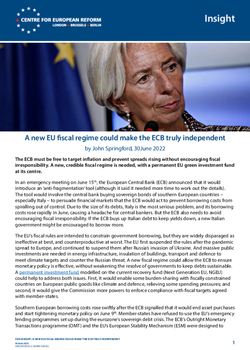
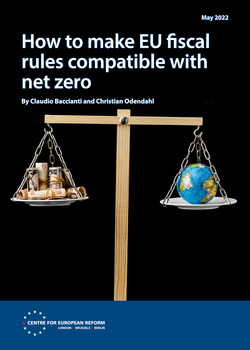
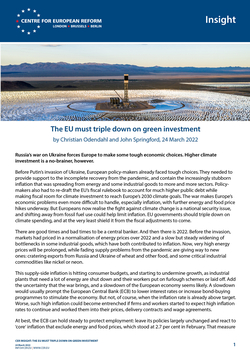
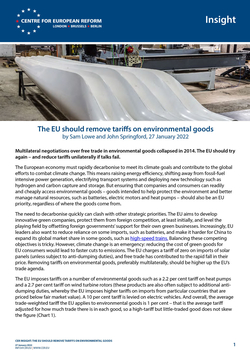
Add new comment